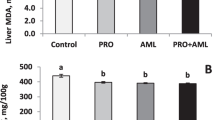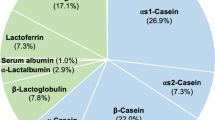Abstract
Lactation is a physiological state that has been shown to modify protein metabolism in camels. Few data are available concerning the changes in protein fractions in lactating camels. This study aimed to investigate the effect of lactation on serum protein fractions in camels. Thirty (30) apparently healthy lactating Arabian camels (age 8–12 years, body weight 600–700 kg, parity 2–3). The animals were divided to three equal groups (10 each), as early lactation (< 90 days after parturition), mid-lactation (91–180 days), and late lactation (≥ 181 days). Blood samples were collected by jugular venipuncture, and serum harvested was used to determine total protein concentration ([TP]) and serum protein fractions using capillary electrophoresis technique. ANOVA (Levine’s and post hoc tests) were used to assess the difference between the groups. Lactating camels showed electrophoretic pattern composed of albumin, α1, α2, β1, β2, and γ-globulins. Serum-[TP] decreased (P ≤ 0.05) during early and mid-lactation to 67.10 and 65.15 g/l, respectively, compared to late lactation (72.31 g/l). The relative (%) and the absolute (g/l) concentrations of albumin, α1, and α2 fractions and A/G ratio showed no significant differences, while β1 and β2 decreased (P < 0.05) during early lactation (6.62%, 4.40 g/l) and mid-lactation (4.58%, 2.92 g/l) compared to mid (10% and 6.42 g/l) and late lactation (9.90%7.20 g/l), respectively. The γ-globulins increased (P < 0.01) during early lactation (21.08% and 14 g/l) compared to mid-lactation (12.40% and 8.12 g/l); however, it decreased (P < 0.05) during mid-lactation compared to late lactation (18.38% and 13.33 g/l). Capillary electrophoresis had been successfully used to assess and interpret the serum protein patterns during early, mid, and late lactations in camels. The results provided baseline data for dairy camel, which could be useful for researchers, veterinary practitioners, and those who work in the field of animal nutrition.


Similar content being viewed by others
Data availability
The authors confirm that the data supporting the findings of this study are available within the article.
References
Abdoslam O, Bayt-Almal M, Almghrbe A, Algriany O (2018) Serum protein electrophoretic pattern in one-humped camels (Camelus dromedarius) in Tripoli, Libya. Open Vet J 8:1−4. https://doi.org/10.4314/ovj.v8i1.1
Ahmadi-hamedani M, Ghazvinian K, Kokhaei P, Barati, M, Mahdavi, A (2014) Comparison of effects of age and sex on serum protein electrophoretic pattern in one-humped camels (Camelus dromedarius) in Semnan, Iran. Open Vet J 4:4−8. PMC4629590
Axay J, Haque, F, Lateef A, Patel A, Patel P, Bhalakiya N (2017) Study on blood metabolites and leukocyte indices of Kutchi camels during different stages of lactation. J Anim Health Prod 5(3):92–96. https://doi.org/10.17582/journal.jahp/2017/5.3.92.96
Baumgard LH, Collier JR, Bauman DE (2017) A 100-year review: regulation of nutrient partitioning to support lactation. J Dairy Sci 100(12):10353–10366. https://doi.org/10.3168/jds.2017-13242
Bekele T, Zeleke M, Baars RMT (2002) Milk production performance of the one humped camel (Camelus dromedarius) under pastoral management in semi-arid eastern Ethiopia. Livestock Prod Sci 76(1–2):37–44. https://doi.org/10.1016/S0301-6226(01)00333-5
Bell A, Burhans WS, Overton TR (2000) Protein nutrition in late pregnancy, maternal protein reserves and lactation performance in dairy cows. Proceedings of the Nutrition Society 59(1):119–126. https://doi.org/10.1017/s0029665100000148
Bobbo T, Fiore E, Gianesella M, Morgante M, Gallo L, Ruegg PL, Bittante G, Cecchinato A (2017) Variation in blood serum proteins and association with somatic cell count in dairy cattle from multi-breed herds. Animal 11(12):2309–2319. https://doi.org/10.1017/S1751731117001227
Bossuyt X (2006) Advances in serum protein electrophoresis. Adv Clin Chem 42:43–80. https://doi.org/10.1016/s0065-2423(06)42002-3
Cecchinato A, Bobbo T, Ruegg PL, Gallo L, Bittante G, Pegolo S (2018) Genetic variation in serum protein pattern and blood β-hydroxybutyrate and their relationships with udder health traits, protein profile, and cheese-making properties in Holstein cows. J Dairy Sci 101:11108–11119. https://doi.org/10.3168/jds.2018-14907
Celeska I, Janevski A, Dzadzovski I, Ulchar I, Kirovski D (2015) The dynamics of biochemical parameters in blood of clinically healthy Holstein cows from day 5 before today 60 after calving. Maced Vet Rev 38:189−193. https://doi.org/10.14432/j.macvetrev.2015.07.049
Ceron JJ, Caldin M, Martinez-Subiela S (2010) Electrophoresis and acute phase protein measurement. In: Douglas J, Weiss K, Wardrop J (eds) Schalm’s veterinary hematology, 6th edn. Publication, Wiley-Blackwell A John Wiley & Sons Ltd, pp 1157–1161
Cozzi G, Ravarotto L, Gottardo F, Stefani AL, Contiero B, Moro L, Brscic M, Dalvit P (2011) Short communication: Reference values for blood parameters in Holstein dairy cows: effects of parity, stage of lactation, and season of production. J Dairy Sci 94(8):3895–3901. https://doi.org/10.3168/jds.2010-3687
Djuricic D, Dobronic T, Grizelj J, Gracner D, Harapin I, Stanin D, Folnozic I, Getz I, Cvitkovic D, Samardzia M (2011) Concentrations of total protein and albumin and AST AP, CK and GGT activities in the blood serum of Boer and Saanen goats during puerperium. Reprod Domest Anim 46(4):674–677. https://doi.org/10.1111/j.1439-0531.2010.01726.x
Eckersall PD (2008) Proteins, proteomics, and the dysproteinemias. In: Kaneko JJ, Harvey JW, Bruss ML (eds) Clinical biochemistry of domestic animals, 6th edn. Academic Press, Elsevier Inc., USA, pp 117–155
Eisa MO, Mustafa AB (2011) Production systems and dairy production of Sudan camel (Camelus dromedarius): A review. Middle- East J Sci Res 7(2):132–135
Elkhair NM (2016) Influence of age and sex on certain serum biochemical parameters of dromedary camels (Camelus dromedarius). Nova J Med Bio Sci 5(3):1–8
Elkhair NM, Hartmann H (2014) Serum protein capillary electrophoretic pattern in camels (Camelus dromedarius): influence of age and sex. J Life Sci 8(1):78–81
El-Sayed A (2020) Evaluation of hematological and biochemical changes in dromedary camel during the different stages of lactation. Mansoura Vet Med J 21(3):121−124. https://doi.org/10.35943/mvmj.2020.21.320
El-Sherif MMA, Assad F (2001) Changes in some blood constituents of Barki ewes during pregnancy and lactation under semi-arid conditions. Small Rumin Res 40(3):269–277. https://doi.org/10.1016/s0921-4488(01)00174-2
El-Tarabany MS, El-Tarabany AA, Roushdy EM (2018) Impact of lactation stage on milk composition and blood biochemical and hematological parameters of dairy Baladi goats. Saudi J Biol Sci 25:1632–1638. https://doi.org/10.1016/j.sjbs.2016.08.003
Faye B (2016) The camel, new challenges for a sustainable development. Trop Anim Health Prod 48(4):689–692. https://doi.org/10.1007/s11250-016-0995-8
Faye B, Bengoumi M (2018) Camel clinical biochemistry and hematology. Springer International Publishing
Gianesella M, Fiore E, Arfuso F, Vecchio D, Curone G, Morgante M, Mazzotta E, Badon T, Rossi P, Bedin S, Zumbo A, Piccione G (2019) Serum haptoglobin and protein electrophoretic fraction modifications in buffaloes (Bubalus bubalis) around calving and during early lactation. J Dairy Res 86(3):291–295. https://doi.org/10.1017/S0022029919000438
Inc SPSS (2011) IBM SPSS Statistics Base 20. SPSS Inc, Chicago, IL
Kaneko JJ, Harvey JW, Bruss ML (2008) Clinical biochemistry of domestic Animals, 6th edn. Elsevier Academic Press, London
Karapehlivan M, Atakisi F, Atakisi O, Yucayurt R, Pancarci SM (2007) Blood biochemical parameters during the lactation and dry period in Tuj ewes. Small Rumin Res 73(1–3):267–271. https://doi.org/10.1016/j.smallrumres.2006.12.006
Kayano M, Kida K (2015) Identifying alterations in metabolic profiles of dairy cows over the past two decades in Japan using principal component analysis. J Dairy Sci 98(12):8764–8774. https://doi.org/10.3168/jds.2015-9791
Kelanemer R, Antoine-Moussiaux N, Moulam N, Abu-medianm AA, Hanzen C, Kaidi R (2015) Effect of nutrition on reproduction performance during the peri-partium period of female camel (Camelus dromedarius) in Algeria. J Anim Vet Adv 14:192–196
Kurpińska A, Jarosz A, Skrzypczak WF (2014) Proteomic studies in pregnant and lactating cows – a review. J Anim Feed Sci 23:203–211. https://doi.org/10.22358/jafs/65680/2014
Muthuramalingam T, Meenakshi Sundaram S, Tensingh Gnanaraj P, Sivakumar T, Vairamuthu S, Rangasamy S, Rachel Jemimah E (2022) Comparative body condition and haemato-biochemical profile of Tellicherry does during pregnancy, lactation and dry period. Indian J Anim Res 56(3):298–304. https://doi.org/10.18805/IJAR.B-4459
Osman T, AL-Busadah K, (2003) Normal concentrations of twenty serum biochemical parameters of she-camels, cows and ewes in Saudi Arabia. Pak J Biol Sci 6:1253–1256. https://doi.org/10.3923/pjbs.2000.1749.1751
Piccione G, Caola G, Giannetto C, Grasso F, Calanni Runzo S, Zumbo A, Pennisi P (2009) Selected biochemical serum parameters in ewes during pregnancy, post-parturition, lactation and dry period. Anim Sci Pap Rep 27:321–330
Piccione G, Messina V, Schembari A, Casella S, Giannetto C, Alberghina D (2011) Pattern of serum protein fractions in dairy cows during different stages of gestation and lactation. J Dairy Res 78(4):421−425. https://doi.org/10.1017/S0022029911000562
Piccione G, Alberghina D, Marafioti S, Giannetto C, Casella S, Assenza A, Fazio F (2012a) Electrophoretic serum protein fraction profile during the different physiological phases in Comasina Ewes. Reprod Domest Anim 47(4):591–595. https://doi.org/10.1111/j.1439-0531.2011.01925.x
Piccione G, Messina V, Marafioti S, Casella S, Giannetto C, Fazio F (2012b) Changes of some haematochemical parameters in dairy cows during late gestation, postpartum, lactation and dry periods. Vet Ir Zootech 58:80–87
Raziq A, Younas M, Kakar MA (2008) Camel a potential dairy animal in difficult environments. Pak J Agri Sci 45(2):263–267
Roubies N, Panouis N, Fytianou A, Katsoulos PD, Giadinis N, Karatzias H (2006) Effects of age and reproductive stage on certain serum biochemical parameters of Chios sheep under Greek rearing conditions. J Vet Med 53(6):277–281. https://doi.org/10.1111/j.1439-0442.2006.00832.x
Schwartz HJ (1992) Introduction. The camel (Camelus dromedarius) in Eastern Africa. H Schwartz and M Dioli (eds). In: The one-humped camel in eastern Africa. A pictorial guide to diseases, health care and management. Verlag Josef Margraf, Federal Republic of Germany 1−7
Stellwagen NC (2009) Electrophoresis of DNA in agarose gels, polyacrylamide gels and in free solution. Electrophoresis 30(1):S188–S195. https://doi.org/10.1002/elps.200900052
Štolcová M, Řehák D, Bartoň L, Rajmon R (2020) Blood biochemical parameters measured during the periparturient period in cows of Holstein and Fleckvieh breeds differing in production purpose. Czech J Anim Sci 65:172–181. https://doi.org/10.17221/99/2020-CJAS
Tóthová C, Nagy O, Seidel H, Kováč G (2013) Serum protein electrophoretic pattern in clinically healthy calves and cows determined by agarose gel electrophoresis. Comp Clin Pathol 22(1):15–20. https://doi.org/10.1007/s00580-011-1363-8
Tóthová C, Nagy O, Kováč G (2016) Serum proteins and their diagnostic utility in veterinary medicine: a review. Vet Med 61:475–496. https://doi.org/10.17221/19/2016-VETMED
Tóthová C, Nagy O, Nagyová V, Kováč G (2018) Serum protein electrophoretic pattern in dairy cows during the periparturient period. J Appl Anim Res 46(1):33–38. https://doi.org/10.1080/09712119.2016.1256293
Weichselbaum TE (1946) An accurate and rapid method for the determination of proteins in small amounts of blood, serum and plasma. Am J Clin Pathol 16(3):40–49. https://doi.org/10.1093/ajcp/16.3_ts.40
Acknowledgements
The authors would like to thank the technician staff at Department of Physiology, Faculty of Veterinary Medicine, University of Khartoum for laboratory assistance.
Author information
Authors and Affiliations
Contributions
Conceived and designed the experiment: Nawal M Elkhair, Abeer A Adam. Provide supervision for animal health assessment during experiment: Abeer A Adam. Performed the experiment: Abeer A Adam. Analyzed the data: Nawal M Elkhair, Abeer A Adam. Data interpretation and scientific discussion: Nawal M Elkhair, Abeer A Adam. Contributed reagents/materials: Nawal M Elkhair, Abeer A Adam. Writing the manuscript: Nawal M Elkhair, Abeer A Adam. All authors reviewed information, wrote, and approved the final manuscript.
Corresponding author
Ethics declarations
Funding
The study was funded by Mrs. Abeer Ali Ahmed Adam.
Conflict of interest
The authors declare that they have no conflict of interest.
Ethical approval
The study was approved by Animal Ethics Committee of Sudan Veterinary Council (EA/0024/2018). All experimental procedures, including animal care, were conducted in accordance with the standards established by Animal Ethics Committee of Sudan Veterinary Council, Sudan. The sampling from experimental animals was strictly conducted under veterinary supervision.
Informed consent
For this type of study, informed consent is not required.
Consent for publication
For this type of study, consent for publication is not required.
Additional information
Publisher's Note
Springer Nature remains neutral with regard to jurisdictional claims in published maps and institutional affiliations.
Rights and permissions
Springer Nature or its licensor (e.g. a society or other partner) holds exclusive rights to this article under a publishing agreement with the author(s) or other rightsholder(s); author self-archiving of the accepted manuscript version of this article is solely governed by the terms of such publishing agreement and applicable law.
About this article
Cite this article
Adam, A.A.A., Elkhair, N.M. Serum protein capillary electrophoretic pattern during lactation period in camels (Camelus dromedarius). Comp Clin Pathol 32, 599–605 (2023). https://doi.org/10.1007/s00580-023-03468-z
Received:
Accepted:
Published:
Issue Date:
DOI: https://doi.org/10.1007/s00580-023-03468-z




